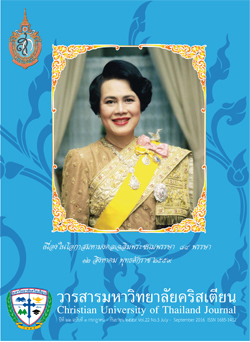การพัฒนาเครื่องดื่มจากข้าวไรซ์เบอร์รี่เสริมงาดำ
บทคัดย่อ
งานวิจัยนี้ศึกษาการพัฒนาเครื่องดื่มสุขภาพจากข้าวไรซ์เบอร์รี่เสริมงาดำเพื่อผลิตเป็นอาหารมื้อว่างสำหรับผู้ป่วยเบาหวานชนิดที่ 2 น้ำข้าวไรซ์เบอร์รี่ถูกเตรียมโดยใช้การทดสอบทางประสาทสัมผัสจากผู้ชิมจำนวน 25 คน เพื่อศึกษาสูตรเบื้องต้นที่เหมาะสมของอัตราส่วนระหว่างข้าวไรซ์เบอร์รี่ต่อน้ำและปริมาณงาดำที่เหมาะสม ตัวอย่างข้าวไรซ์เบอร์รี่และน้ำถูกเตรียมที่อัตราส่วน 1:15 1:17.5 และ 1:20 ตามลำดับ สูตรตัวอย่างข้าวไรซ์เบอร์รี่และน้ำอัตราส่วน 1:20 ได้รับคะแนนการทดสอบทางด้านประสาทสัมผัสสูงสุดด้านเนื้อสัมผัส (Texture) และการยอมรับโดยรวม (Overall acceptance) แตกต่างอย่างมีนัยสำคัญทางสถิติ (p<0.05) สูตรเบื้องต้นดังกล่าวนำไปศึกษาปริมาณงาดำคั่วที่ระดับร้อยละ 0.5 1.0 1.5 และ 2.0 ตามลำดับ โดยพบว่ากลิ่นรส (Flavor) เนื้อสัมผัส รสชาติ (Taste) และการยอมรับโดยรวมของตัวอย่างที่ใส่งาดำคั่วร้อยละ 1.0 ได้รับคะแนนสูงกว่าระดับอื่น ดังนั้นสูตรการผลิตน้ำข้าวไรซ์เบอร์รี่เสริมงาดำที่เหมาะสมคือ ข้าวไรซ์เบอร์รี่ 1 ส่วน น้ำ 20 ส่วนและงาดำคั่วร้อยละ 1.0 นำไปวิเคราะห์องค์ประกอบทางเคมี ปริมาณสารออกฤทธิ์ทางชีวภาพ (Bioactive compounds) การต้านออกซิเดชัน คุณสมบัติทางกายภาพและจุลินทรีย์ พบว่าน้ำข้าวไรซ์เบอร์รี่เสริมงาดำมีพลังงานทั้งหมด 20.58 kcal/100 มิลลิลิตร มีปริมาณสารประกอบแอนโทไซยนิน โดยรวม (Total anthocyanins) มีค่าเท่ากับ 0.07 มิลลิกรัมต่อ 100 มิลลิลิตร สารต้านออกซิเดชัน โดยรวมวิเคราะห์ด้วยวิธี ORAC มีค่าเท่ากับ 158.65 mole TE ขณะที่การยับยั้งออกซิเดชันทดสอบด้วยวิธี DPPH มีค่าร้อยละ 39.96 ค่าความหนืดของน้ำข้าวไรซ์เบอร์รี่ (Viscosity) มีค่าเท่ากับ 178.40 เซนติพอยส์ ผลิตภัณฑ์มีสีม่วงเทาโดยมีค่า lightness (L) ค่า yellowness (b*) และค่า redness (a*) เท่ากับ 0.16, 0.23 และ 0.01 ตามลำดับ ปริมาณยีสต์และรา และโคลิฟอร์มไม่เกินมาตรฐานตามข้อกำหนดของคณะกรรมการอาหารและยา
เอกสารอ้างอิง
กระทรวงสาธารณสุข. (2556). ประกาศกระทรวงสาธารณสุข ฉบับ 356 เรื่อง เครื่องดื่มในภาชนะปิดสนิท. เล่ม 310 ตอนพิเศษ (83 ง.)
รุจิรา สัมมะสุต. (2552). หลักการปฏิบัติด้านโภชนบำบัด. ปราจีนบุรี: สุพัตราการพิมพ์.
วันวิสาข์ สุธีรพจน์. (2557). ข้าว: เป้าการส่งออกปี 2558. สำนักพัฒนาการค้าและธุรกิจการเกษตรและอุตสาหกรรม. [ออนไลน์] . สืบค้นเมื่อวันที่ 14 สิงหาคม 2558, จาก https://www.ditp.go.th/contents_attach/92369/92369.pdf.
อัญชลี ศรีจำเริญ. (2553). อาหารและโภชนาการ: การป้องกันและบำบัดโรค. พิมพ์ครั้งที่ 3. กรุงเทพ: จุฬาลงกรณ์มหาวิทยาลัยกรุงเทพฯ.
AMERICAN DIABETES ASSOCIATION.( 2007). "Nutrition recommendations and interventions for Diabetes". Diabetics Care. (30).
AOAC. (2012). Official Methods of Analysis of AOAC INTERNATIONAL (2012). 19Ed. Gaithersburg, MD, USA: AOAC international.
BAM .(2002). Microbiological Methods & Bacteriological Analytical Manual (online). [ออนไลน์]. สืบค้นเมื่อวันที่ 15 สิงหาคม 2558, จาก https://www.fda.gov/Food/FoodScienceResearch/LaboratoryMethods/ucm2006949.htm.
Da Costa, C. T., Nelson, B. C., Margolis, S. A., & Horton, D. (1998). " Separation of blackcurrant anthocyanins by capillary zone electrophoresis" . Journal of Chromatography A. 799 (1-2) : 321-327.
Domingueti, C.P., Dusse, L.M.S., Carvalho, M.D.G., Sousa, L.P.D., Gomes, K.B., & Fernandes, A.P. (2016). " Diabetes mellitus: The linkage between oxidative stress, inflammation,hypercoagulability and vascular complications". Journal of Diabetes and Its Complications. 30(4): 738-745.
Fan, L., Zhang, S., Yu, L., & Ma, L. (2006). " Evaluation of antioxidant property and quality of breads containing Auricularia auricula polysaccharide flour". Food Chemistry. 30(101) : 1158-1163.
Gerstenmeyer, E., Reimer, S., Berghofer, E., Schwartz, H., & Sontag, G. (2013). "Effect of thermal heating on some lignans in flax seeds, sesame seeds and rye". Food Chemistry. 138(2-3): 1847-1855.
Giacco, F., & Brownlee, M. (2010). Oxidative stress and diabetic complications. Circ.Res. 107(9): 1058-1070.
Hung, W-L., Liao, C-D., Lu, W-C., Ho, C-T., & Hwang, L.S. (2016). " Lignan glycosides from sesame meal exhibit higher oral bioavailability and antioxidant activity in rat after nano/submicrosizing". Journal of Functional Foods. 23:511-522.
Ibrahim, M.A., Koorbanally, N.A., & Islam, M. (2014). "Antioxidative activity andinhibition of key enzymes linked to type-2 diabetes (-glucosidase and-amylase)". Acta Pharmaceutica. 64(3): 311-324.
Janat, B., Oveisi, M.R., Sadeghi, N., Hajimahmoodi, M., Behzad, M., Choopankari, E., & Behfar, A.A. 2010. "Effects of roasting temperature and time on healthy nutraceuticals of antioxidants and total phenolic content in Iranian sesame seed (Sesamum Indicum L.)". Iranian Journal of Environmental Health Science and Engineering. 7(1): 97-102.
Khanal, RC., Howard, L.R., & Prior, R.L.( 2010). "Effect of heating on the stability of grape and blueberry pomace procyanidins and total anthocyanins". Food Research International. 43 : 1464-1469.
Kongkachuichai, R., Prangthip, P., Surasiang, R., Posuwan, J., Charoensiri, R., Kettawan, A. &Vanavichit, A. (2013). "Effect of riceberry oil (deep purple oil; Oryza sativa Indica) supplementation on hyperglycemia and change in lipid profile in Streptozotocin (STZ) induced diabetic rats fed a high fat diet". International Food Research Journal. 20(2): 873-882.
K hk nen, M.P. and Heinonen, M. (2003). "Antioxidant activity of anthocyanins and their Aglycons". Journal of Agriculture and Food Chemistry. 51(13): 628-633.
Leardkamolkarn, V., Thongthep, W., Suttiarporn, P.,Kongkachuichai, R., Wongpornchai, S., & Wanavijitr, A. (2011). "Chemopreventive properties of bran extracted from a newly-developed Thai rice: The Riceberry". Food Chemistry. 125(3): 978-985.
Lin, Y. C., & Chou, C. C. (2009). "Effect of heat treatment on total phenolic and anthocyanin contents as well as antioxidant activity of the extract from Aspergillus awamori-fermented black soybeans, a healthy food ingredient". International Journal of Food Science and Nutrition. 60(7): 627-636.
Mulinacci, N., Ieri, F., Giaccherini, C., Innocenti, M., Andrenelli, L., & Canova, G. (2008). "Effect of cooking on the anthocyanins, phenolic acids, glycoalkaloids, and resistant starch content in two pigmented cultivars of Solanum tuberosum L.Journal of Agricultural and Food Chemistry. 56(4): 11830-11837.
Ou B., Hampsch-Woodill M., & Prior R.L. (2001). "Development and validation of an improved oxygen radical absorbance capacity assay using fluorescein as the fluorescent probe". Journal of Agricultural and Food Chemistry. 49(10): 4619-4926.
Prangthip, P., Surasiang, R., Charoensiri, R., Leardkamolkarn, V., Komindr, S., Yamborisut, U., Vanavichit, A., & Kongkachuichai, R. (2013). "Amelioration of hyperglycemia, hyperlipidemia, oxidative stress and inflammation in steptozotocin-induced diabetic rats fed a high fat diet by riceberry supplement". Journal of Functional foods. 5 : 195-203.
Ruethaithip Surasiang. (2011). "Effect of Cold Press Rice Berry Oil (dark violet oil) on Blood Glucose, Insulin level and Oxidative stress in High Fat Diet Fed to Streptozotocin-Induced Diabetic Rats". 20 National Grad Research Conference.
Sancho RAS, Pastore GM. (2012). "Evaluation of the effects of anthocyanins in type 2 diabetes". Food Research International. 46(1):378-386.
Sankar, D., Ali, A., Sambandam, G, & Rao, R. (2011). "Sesame oil exhibits synergistic effect with anti-diabetic medication in patients with type 2 diabetes mellitus". Clinical Nutrition. 30(3): 351-358.
Shahidi, F., Amarowicz, R., Abou-Gharbia, H.A., Shehata, A. & Adel, Y., (1997). "Endogenous antioxidants and stability of sesame oil as affected by processing and storage". Journal of American Oil Chemists' Soceity. 74(2): 143-148.
Shikov, V., Kammerer, D. R., Mihalev, K., Mollov, P., & Carle, R. (2008). "Heat stability of strawberry anthocyanins in model solutions containing natural co-pigments extracted from rose (Rosa damascena Mill. petals". Journal of Agricultural and Food Chemistry. 56(18): 8521-8526.
Weisel, T., Baum, M., Eisenbrand, G., Dietrictch, H., Will, F., Stockis, J.P., Kulling, S., R fer, K., Johannes, C., & Christine Janzowski, C. (2006). "An anthocyanin/polyphenolic rich fruits juice reduces oxidative DNA damage and increase glutathione level in healthy probands". Biotechnology Journal. 1(4): 388-397.
Xu W.T, Zhang F.F, Luo Y.B, Ma L.Y, Kou X.H, & Huang K.L. (2009). "Antioxidant activity of a water soluble polysaccharide purified from Pteridium aquilinum". Carbohydrate Research. 344(2): 217-222.



